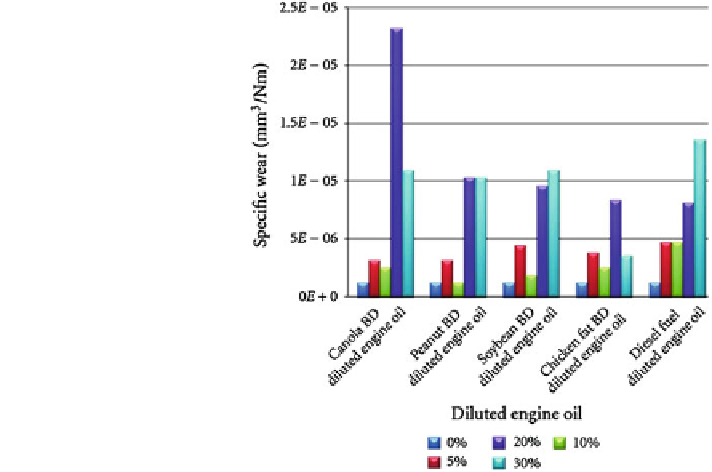Environmental Engineering Reference
In-Depth Information
Fig. 5 Speci
c wear for
mixtures of four biodiesels
and mineral diesel diluting the
lubricating oil (Shanta et al.
2011
)
was in 5, 10, 20, and 30 % volume ratios. For all tested biodiesels, contaminated
mixtures, the average friction force did not vary signi
cantly as compared to that
for mineral diesel contaminated and that for pure oil (Fig.
5
). As per results for the
0
10 % dilution range, the observed wear for each biodiesel mixture was not
substantially different and even slightly lower than that for same percentage of
mineral diesel-fuel contamination. For the four tested biodiesel mixtures, the
measured wear seemed to peak for around 20 % blends. However, the mineral
diesel in oil mixture showed a monotonic increase of wear in the tested 0
-
30 %
-
contamination interval (Shanta et al.
2011
).
Arumugam and Sriram (
2012
) addressed the issue of friction and wear charac-
teristics of diesel engine cylinder liner
piston ring combinations under different
lubricating conditions using a pin-on-disk wear tribometer. They reported that the
rapeseed oil-based bio-lubricants and biodiesel-contaminated synthetic lubricants
exhibited better performance in terms of wear, friction, and frictional force under
similar operating conditions.
-
4.3 Wear Metal Measurement Through Lubricating Oil
Analysis
The quantitative evaluation of wear particles present in oil gives the magnitude of
engine component deterioration, while qualitative analysis indicates its origin.
Sinha and Agarwal (
2010
) analyzed wear metal in lubricating oil samples and

Search WWH ::

Custom Search